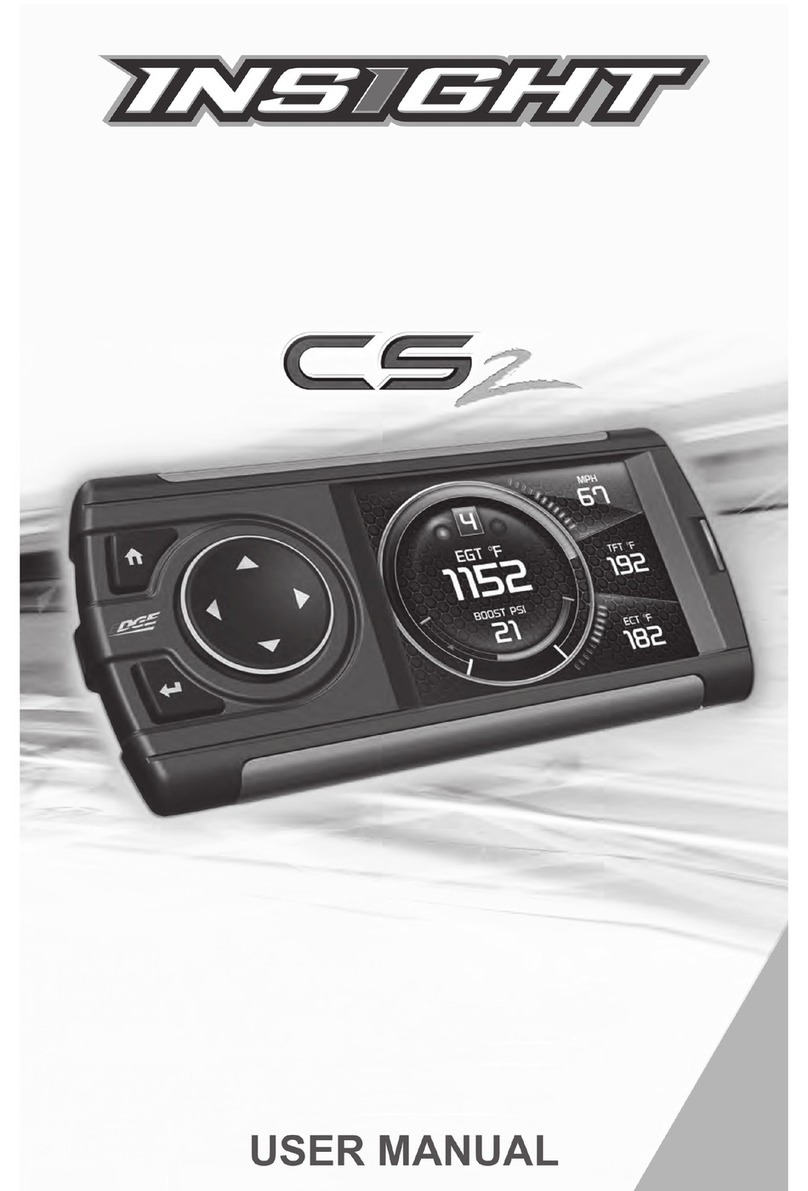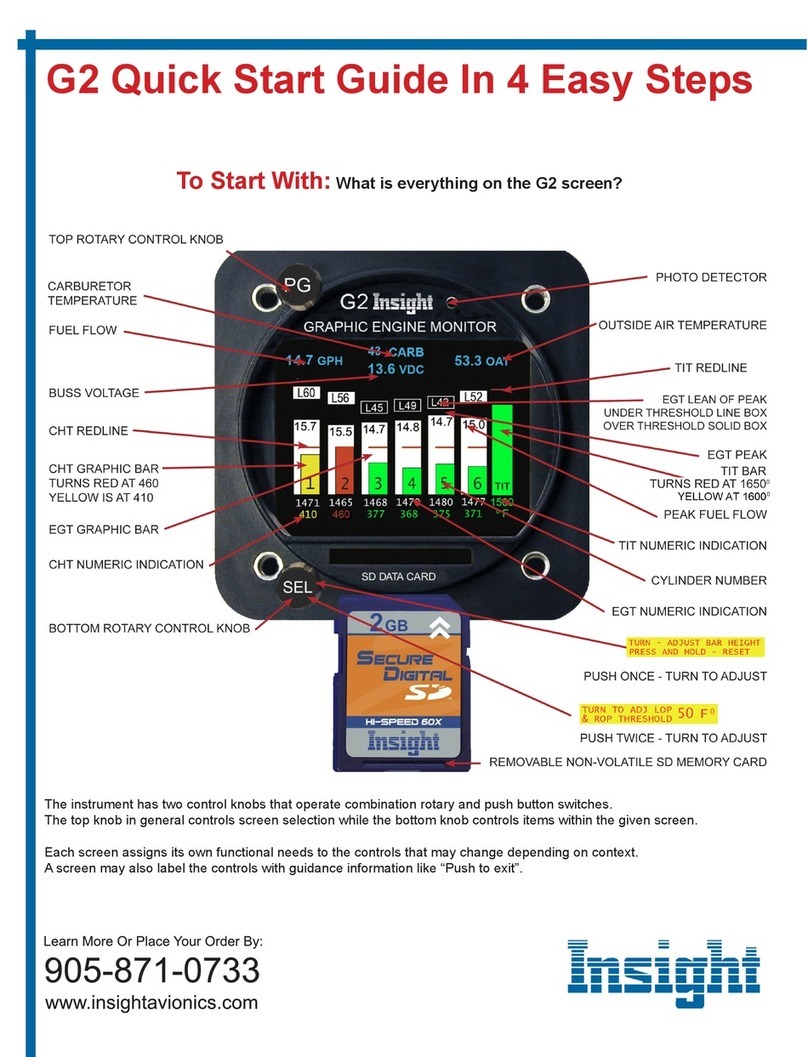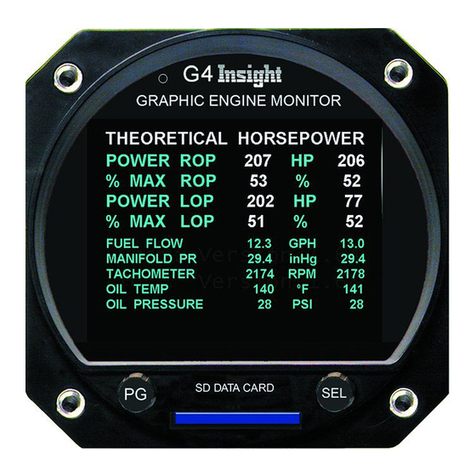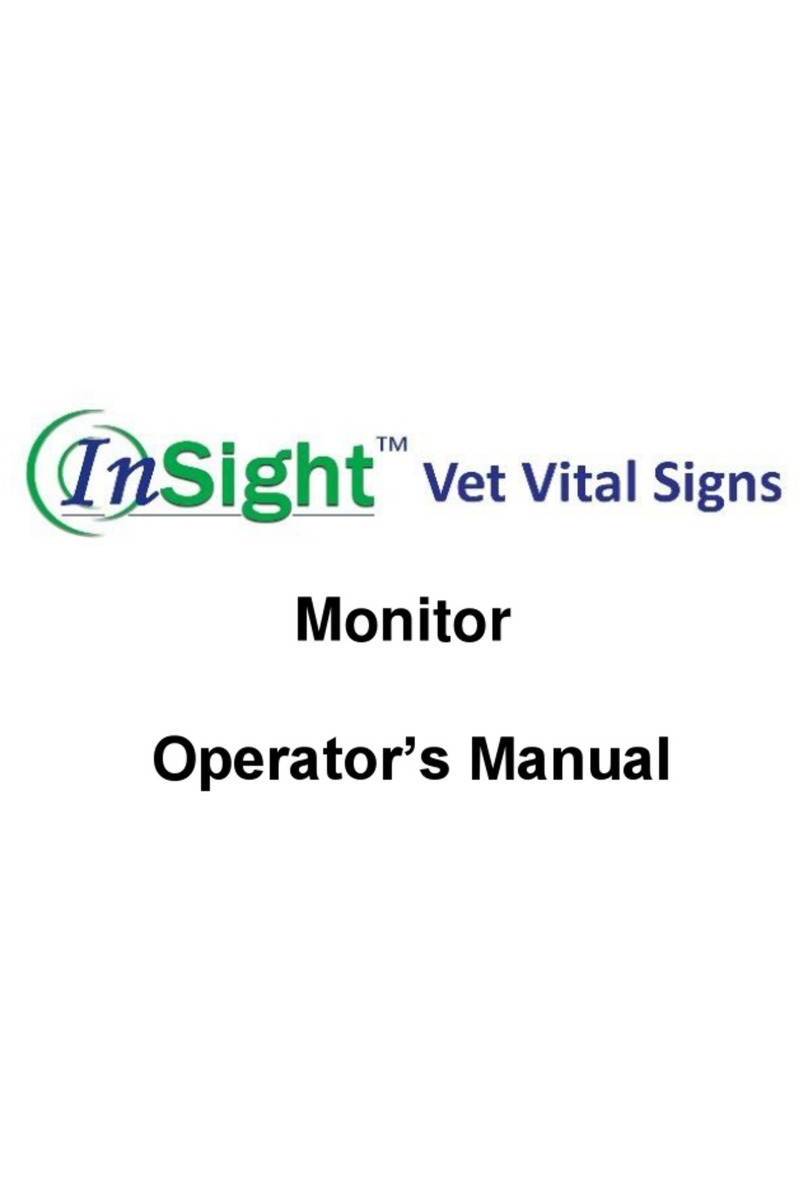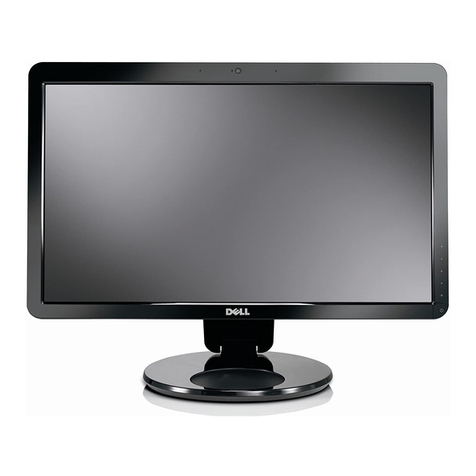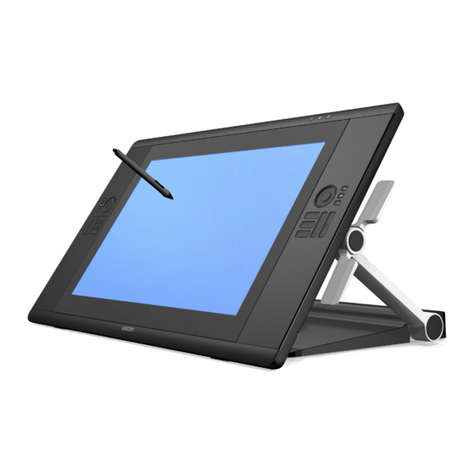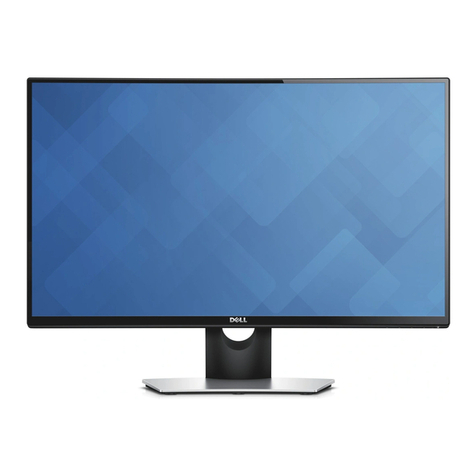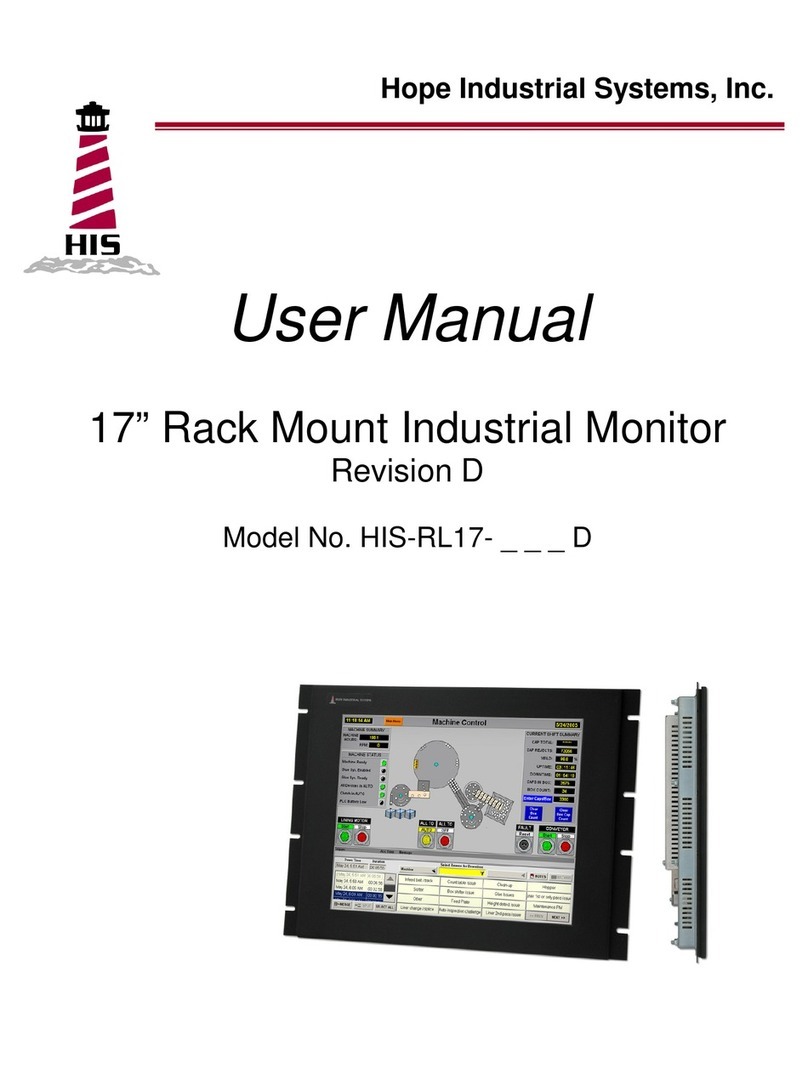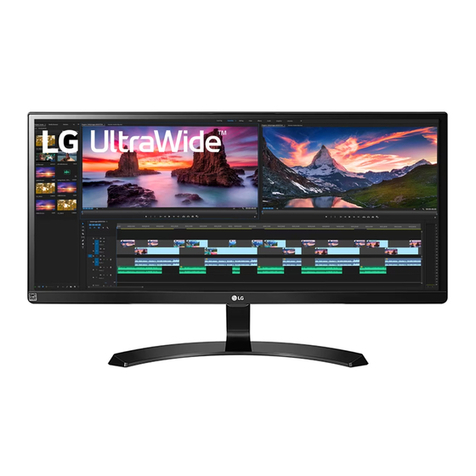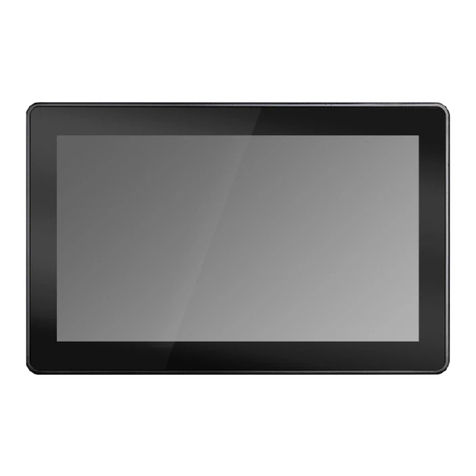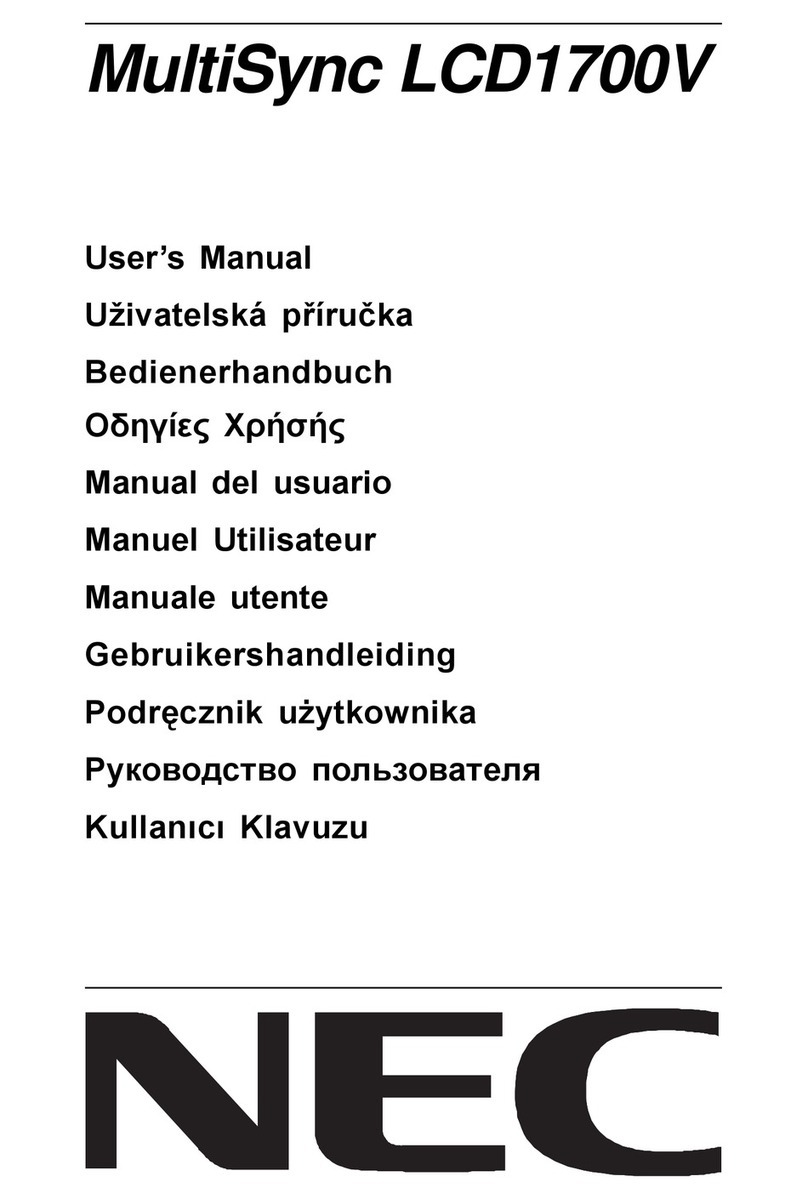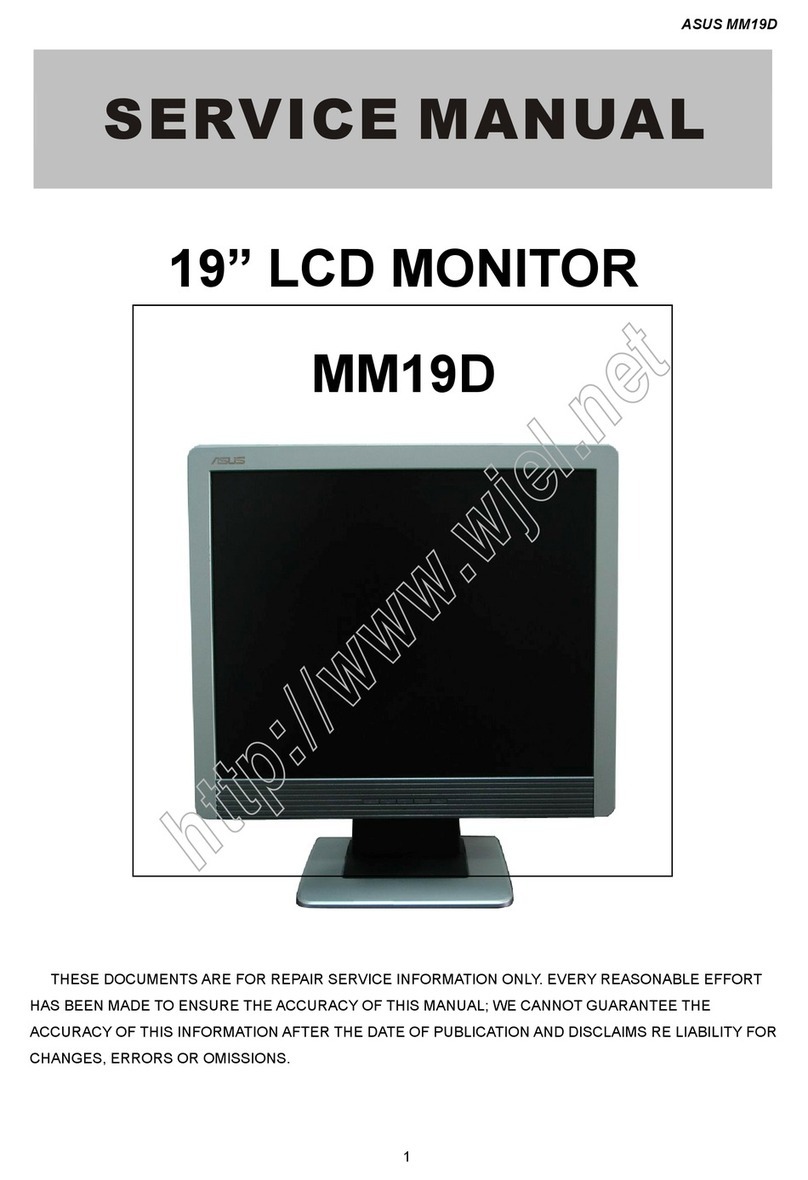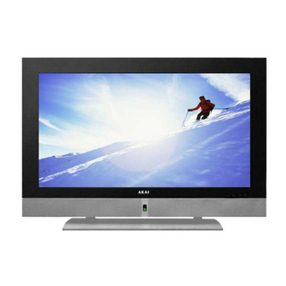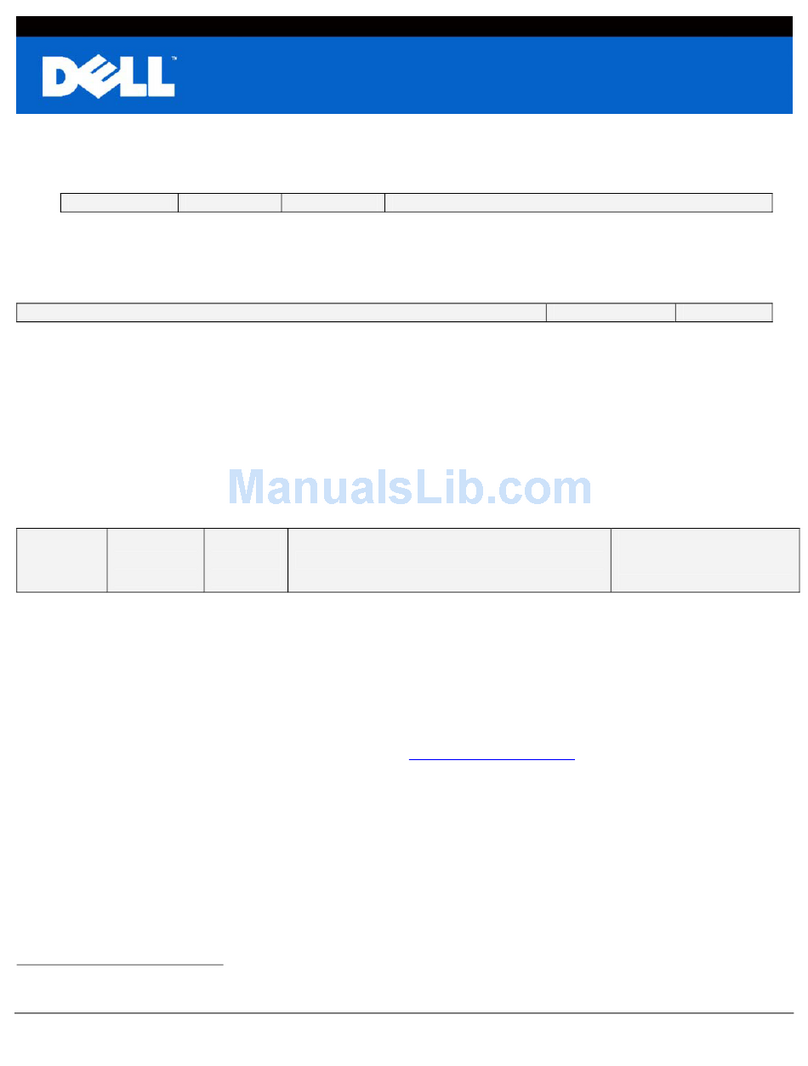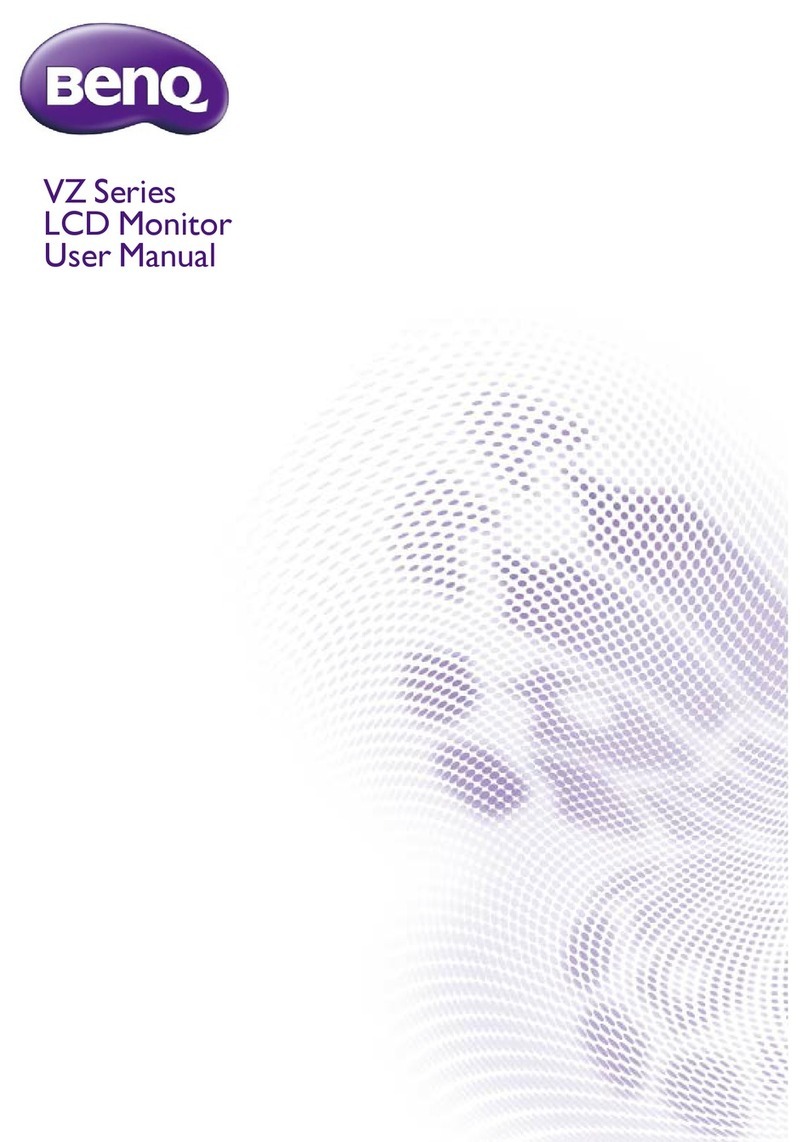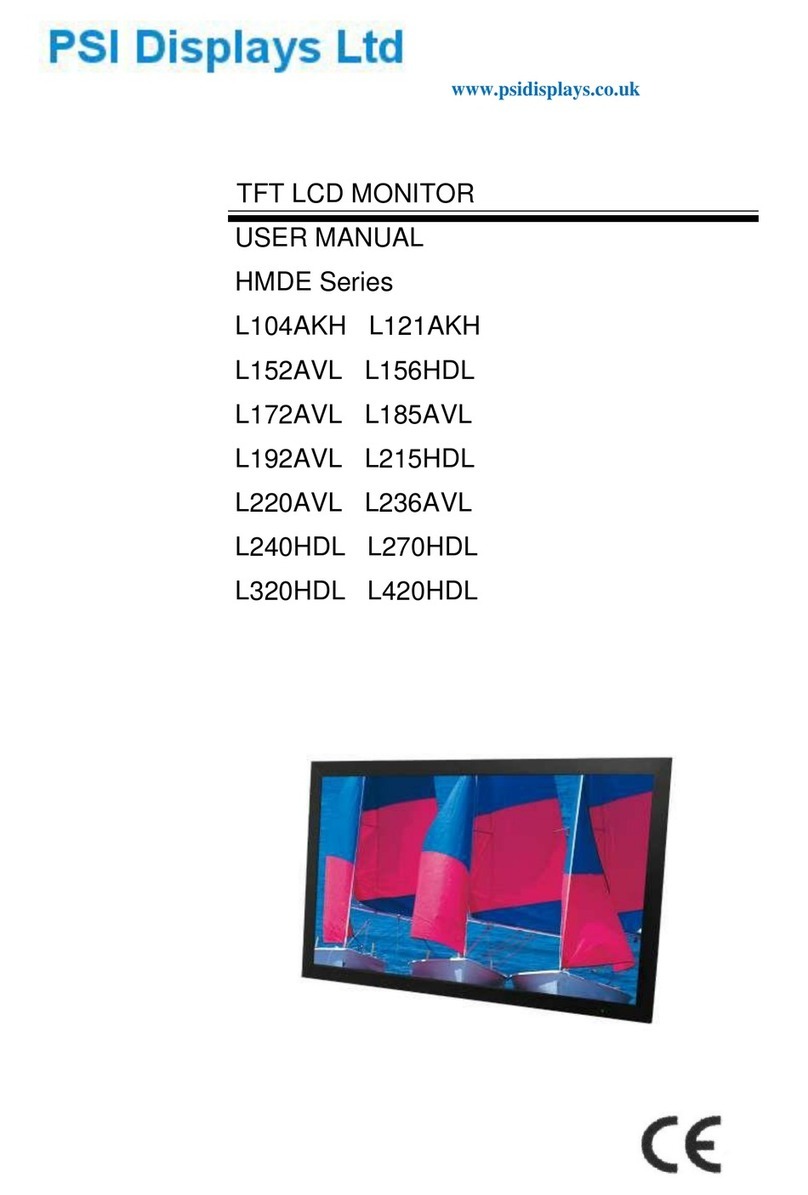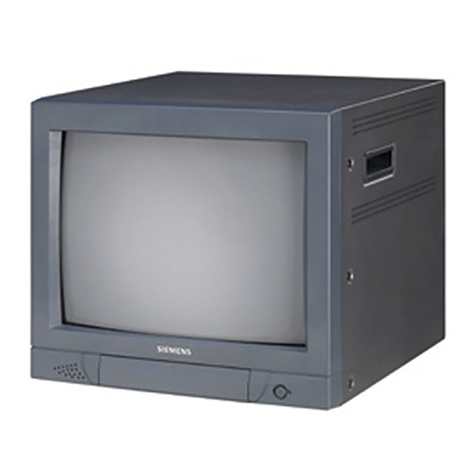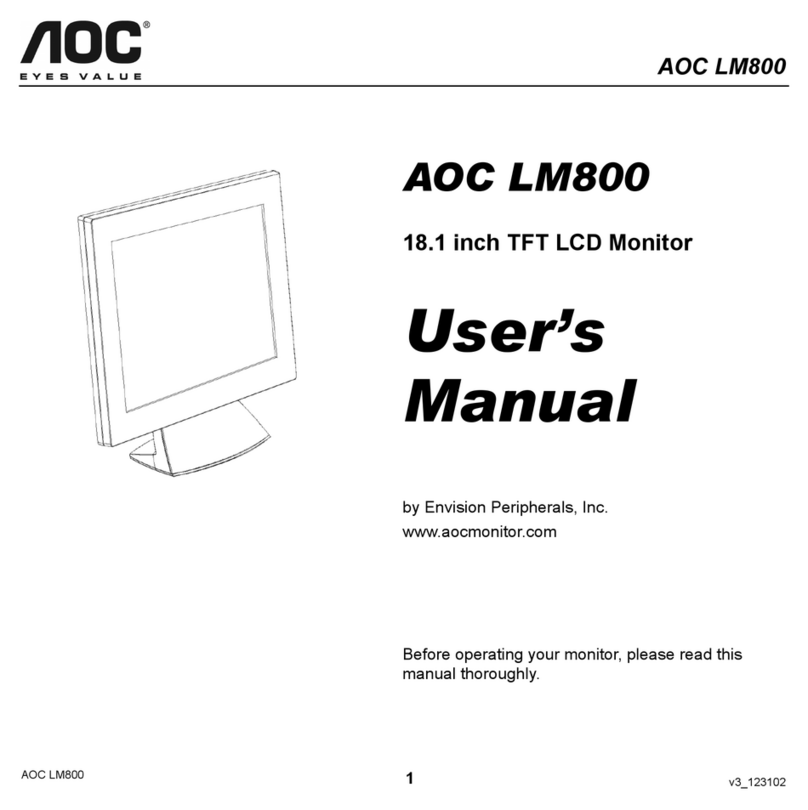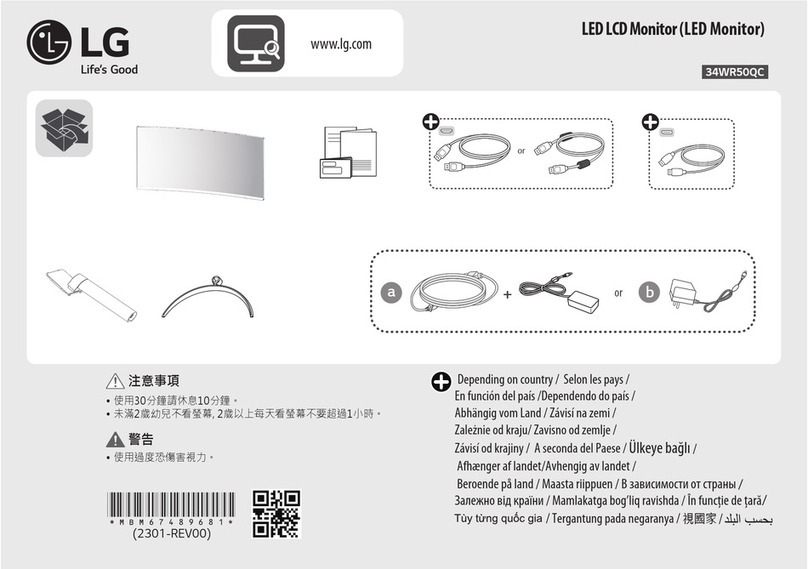INSIGHT Vital Signs Plus ECG User manual

Monitor
Operator’s Manual

Contents
Preface...................................................................................................................... 1
Chapter I Overview ................................................................................................... 3
1.1 Introduction...................................................................................................... 4
1.2 Introduction to the Display Interface................................................................. 8
Chapter II Installation of the Monitor........................................................................ 11
2.1 Unpacking and Checking............................................................................... 11
2.2 Electrical Connection..................................................................................... 11
2.3 Power On....................................................................................................... 11
2.4 Sensor Connection........................................................................................ 12
Chapter III System Menu......................................................................................... 13
3.1 Main Interface................................................................................................ 13
3.2 Menu Setting ................................................................................................. 14
3.3 Working Mode................................................................................................ 15
3.4 User Setting................................................................................................... 16
3.5 Alarm Setting................................................................................................. 17
3.6 Blood Pressure Setting.................................................................................. 18
3.7 Blood Oxygen Setting.................................................................................... 19
3.8 ECG Setting................................................................................................... 20
3.9 ETCO2 setting............................................................................................... 21
3.10 Temperature................................................................................................ 21
3.11 System Setting............................................................................................. 22
3.12 Data Review ................................................................................................ 23
Chapter IV Maintenance and Cleaning.................................................................... 26
4.1 Maintenance and Inspection.......................................................................... 26
4.2 Normal Cleaning............................................................................................ 26
4.3 Cleaning Solution Guidance........................................................................... 26
4.4 Sterilisation.................................................................................................... 27
4.5 Disinfection.................................................................................................... 27
Chapter V Alarm...................................................................................................... 28
5.1 Overview........................................................................................................ 28
5.2 Alarm Properties............................................................................................ 28
5.3 Alarm Mode................................................................................................... 29

5.4 Alarm Status.................................................................................................. 29
5.5 Parameter Alarm............................................................................................ 29
5.6 Measures to be Taken in Case of Alarm........................................................ 29
Chapter VI ECG...................................................................................................... 30
6.1 Instructions for ECG Monitoring..................................................................... 30
6.2 ECG Monitoring Operation Method................................................................ 30
6.3 ECG Operation.............................................................................................. 33
Chapter VII SpO2 Measurement ............................................................................. 36
7.1 SpO2 Monitor instruction ............................................................................... 36
7.2 SpO2 Measurement Operation...................................................................... 37
7.3 SpO2 Monitoring Measurement Limit............................................................. 38
7.4 SpO2 Alarm Information ................................................................................ 38
7.5 Maintenance and Cleaning ............................................................................ 39
Chapter VIII Temperature Measurement................................................................. 40
8.1 Temperature Monitor Instruction.................................................................... 40
8.2 Temperature Alarm Information and Prompt Information ............................... 40
8.3 Maintenance and Cleaning ............................................................................ 41
Chapter IX NIBP Measurement............................................................................... 42
9.1 NIBP Monitor Instruction................................................................................ 42
9.2 NIBP Monitor Measurement Operation .......................................................... 42
9.3 Operation Tips............................................................................................... 43
9.4 NIBP Alarm Information................................................................................. 45
9.5 Maintenance and Cleaning ............................................................................ 46
Chapter X Mainstream CO2 Module........................................................................ 47
10.1 Hardware Interface ...................................................................................... 47
10.2 Proper Connection....................................................................................... 48
10.3 Troubleshooting of Mainstream CO2 Module............................................... 48
10.4 CO2 Compensations.................................................................................... 49
10.5 Apnea Alarm................................................................................................ 49
10.6 Cleaning ...................................................................................................... 49
Appendix I Accessories Specifications .................................................................... 50
Appendix II Product Specifications.......................................................................... 51

1
Preface
This manual introduces the InSight Vital Signs + ECG Monitor's performance,
operation methods and other safety information in detail. This is the best starting
point for new users to start using the monitor.
The following symbols indicate some important tips, which users should pay attention
to:
Warnings are information that you should know how to help avoid injury to animals
and medical personnel.
Caution is the information you should know how to avoid damage to your equipment.
Note is to emphasise important information.
This manual is for personnel who are familiar with the various measurements
performed and have experience in using monitoring equipment.
This monitor is a handheld vital signs monitor which can be used for same-day
surgery, surgery/anaesthesia recovery, emergency room and other occasions to
monitor the vital signs of large and small animals.
This portable monitor is easy to carry and can be powered by the built-in battery.
Practical Range
This monitor is suitable for monitoring and measuring vital signs including heart
rate/pulse rate, non-invasive blood pressure (systolic blood pressure, diastolic blood
pressure, mean blood pressure), electrocardiogram, blood oxygen saturation and
temperature.
Warnings
● This device is not a treatment device.
● If the device is not secured properly, it may fall, causing personal injury or
equipment damage. To prevent personal injury or equipment damage, install the
equipment in a fixed location.
● This device should not be used in the presence of magnetic resonance imaging
(MRI) equipment, otherwise the induced current may cause animal burns.
● This equipment must not be operated in the presence of flammable anaesthetic
gas or other gases.
● This device cannot be used in places with electromagnetic radiation, including
places where mobile phones are used.
● In order to avoid personal injury, only Woodley Equipment Company authorised
personnel can repair the equipment.
● Do not replace the power adapter of this device.
● Do not touch animals, this equipment or the treatment surface during defibrillation.

2
Precautions
● Before use, verify that the calibration is correct and that the device is working
properly.
● Pay attention to the placement of power adapters, conduits and all cables to avoid
the danger of strangling animals or tripping other people.
● This equipment is strictly prohibited to be blocked in order to radiate heat.
● If liquid spills into the cabinet of the device, please disconnect the power
immediately and contact Woodley Equipment Company.

3
Chapter I Overview
■ For a comprehensive understanding of the monitor, please read the overview of the
monitor information in Section 1.1
■ For an introduction to the various information displayed on the screen, please read
the introduction to the screen display information in Section 1.2
■ To master the operation method, please read the key function and basic operation
of the monitor information in Section 6
■ To understand the location of various interfaces, please read the external interface
of the monitor information in Section 3
Warnings
•Do not open the casing of the instrument to avoid possible electric shock hazard.
Any maintenance and upgrade of the monitor must be carried out by Woodley
Equipment Company authorised personnel.
•Do not use this instrument where flammable materials such as anaesthetics are
placed to prevent explosion.
•Before use, the user should check whether the instrument and its accessories are
working normally and safely.
•To prevent delays in treatment, please make an adequate alarm setting for each
animal. At the same time, please check that the alarm sound can be emitted
when the alarm is issued.
•Do not use mobile phones near the monitor. Mobile phones can generate
excessively strong radiation fields that can interfere with the function of the
monitor.
•When the monitor is shared with electrosurgical equipment, the user should take
care to ensure the safety of the animals being monitored.
•Dispose of any waste in accordance with local and national regulations.
Precaution
When in doubt about the integrity of the external grounding of the monitor and its
arrangement, the internal battery must be used for operation.

4
1.1 Introduction
The InSight Vital Signs + ECG Monitor is a small device with a built-in battery which
is convenient for animal transfer. It can monitor and measure vital signs such as
heart rate/pulse rate, non-invasive blood pressure (systolic blood pressure, diastolic
blood pressure, mean blood pressure), electrocardiogram, blood oxygen saturation
and temperature for large or small animals.
Characteristics
•4-inch large screen, colour screen, LCD display.
•The operation of the display interface is simple and convenient.
•Built-in rechargeable battery.
•Large memory.
•Automatic sound.
Working Environment
Working Temperature: 0 ~ 40°C
Transportation and Storage Temperature: -20 ~ 60°C
Working Humidity: ≤ 85%
Transportation and Storage Humidity: ≤ 93%
Operating Altitude: -500 - 4600 meters (-1,600 - 15,000 feet)
Transportation and Storage Altitude: -500 - 13,100 meters (-1600 - 43,000 feet)
Power Adapter
Input: 100-240 (V) AC, 50/60 (Hz)
Output: 5.0 (V) direct current, 2.0 (A)
Built-in Lithium Battery: 3.7V-2000mAh
Warning
Do not use the monitor outside the temperature and humidity range specified by the
manufacturer, otherwise the performance specifications stated in Appendix II will not
be met.
The InSight Vital Signs + ECG Monitor has many functions, as shown in Figure 1-1.
Users can also choose different measurement parameter configurations according to
different needs.
The InSight Vital Signs + ECG Monitor can monitor parameters including
electrocardiogram (ECG), blood oxygen saturation (SpO2), non-invasive blood
pressure (NIBP) and temperature (TEMP). The built-in battery provides convenience
for moving patients and can clearly display 2 to 3 waveforms and all monitoring
parameter information on its high-resolution display interface.

5
1.1.1 Button and Indicator Light
Fig. 1-1 Buttons and Indicator Light
•Power - Switch on/off
•Mute - Press this key to suspend or resume the alarm loudspeaker
•Function 1 - Carry out functions as indicated by text showing on the lower left
corner of screen
•Function 2 - Carry out functions as indicated by text showing on the lower
right corner of screen
•Select - Choose different options on setting menu
•Alarm light - Red light flashes when alarm sounds
•Power light –Red light flashes when charging or in low power. Green light
flashes when fully charged. No flashing under normal conditions
1.1.2 Power Socket
Fig. 1-2 Power Socket
NOTE
Please only use the power adapter supplied. Do not use device whilst it is charging.

6
1.1.3 Reset Micro USB
Fig. 1-3 Reset Micro USB
Open the protecting shell and insert a needle into the reset hole. Press the reset
button, the device will be reset.
Warning
USB data upload, ECG will not appear.
1.1.4 Ports
NIBP: Blood pressure cuff interface.
TEMP: Temperature probe interface.
S & E: The interface between the blood oxygen probe and the ECG lead wire or
between the blood oxygen probe and EtCO2 part.
1.1.5 Cage Clip
Fig. 1-5 Cage Clip
NOTE
Device is supplied with cage clip in situ.
Fig. 1-4 Ports

7
Abbreviations
Abbreviation
Definition
ECG
Electrocardiography
TEMP
Temperature
NIBP
Non-invasive blood pressure
SPO2
Blood oxygen saturation
EtCO2
End tidal carbon dioxide
RR
Respiration rate
HR
Heart rate
PR
Pulse rate
PI
Perfusion index
PVC
Premature ventricular contractions
SYS
Systolic blood pressure
DIA
Diastolic blood pressure
MAP
Mean arterial pressure
Monitor
Continuous measurement mode
Spot
Field mode (multi-user measurement)

8
1.2 Introduction to the Display Interface
The monitor's display screen is a colour LCD screen which can simultaneously
display the collected animal ID, waveform parameters, alarm information provided by
the monitor, monitor status, clock and other prompt information.
The main screen is divided into three areas (as shown in Figure 1-6):
1. Information area①④
2. Waveform area②
3. Parameter area ③
3 Lead ECG Interface 5 Lead ECG Interface
Fig. 1-6 Main Interface
Information Area (①④):
The information area is located at the top of the screen, displaying the status of the
monitor and the current user. The meaning of the content of the information area is
as follows:
"Spot": Refers to the current working mode of the instrument.
"ID: 01": Refers to the current user serial number.
"15:30": Refers to the current time.
: Battery power status.

9
Other prompt messages in the information area appear and disappear at the same
time as the reported status and are divided into:
The monitor prompts information, the physiological alarm is fixed in the area ④; the
technical alarm of NIBP is fixed under the NIBP mmHg, the SpO2 technology alarm
of the ECG 3-lead interface is fixed behind the PI value and the SpO2 technology of
the ECG 5-lead interface. The alarm always appears below SpO2% and the
temperature technical alarm always appears behind Temp.
Monitor alarm information (see the "Alarm Setting" chapter for specific setting
methods).
Alarm mute: This symbol appears when you press the "Mute" button, indicating
that all alarm sounds have been turned off. The voice prompt will not resume until the
operator presses the "mute" button again to turn the alarm sounds back on.
Warning: When the sign appears, the system will not be able to give an alarm
sound so the operator should use this function with special care.
Waveform Area (②):
The waveform area of the ECG 3-lead interface displays 2 waveforms and the
waveform area of the ECG 5-lead interface displays 3 waveforms. The display
sequence can be adjusted. The name of the waveform is displayed on the upper left
of each waveform. ECG leads can be selected according to requirements. Each ECG
wave also shows the gain of this channel and the filter method of the ECG wave.
There is a 1 millivolt ruler on the left side of the ECG waveform. When the menu
displays during screen operation, it will occupy a fixed position in the middle of the
waveform area, making part of the waveform temporarily invisible. After exiting from
the menu, the original screen display will be restored. The waveform is refreshed at
the set rate. For the adjustment of the refresh rate of each waveform, please refer to
the Setting of each parameter.
Parameter Area (③):
The parameter area and the waveform are placed correspondingly. The parameters
displayed in the parameter area are:
ECG
- Heart rate (unit: beats/minute)
SpO2
- SpO2 (unit: %)
- Pulse rate (unit: beats/minute)
NIBP - From left to right, systolic blood pressure, diastolic blood pressure, mean
blood pressure; (unit: mmHg or kPa)
TEMP - Temperature (unit: Celsius ℃or Fahrenheit ℉)

10
Alarm Lights and Alarm Status:
In the normal state, the warning light does not light up.
When an alarm occurs, the alarm light flashes and lights up in red. For details, please
refer to Section 3.5.

11
Chapter II Installation of the Monitor
2.1 Unpacking and Checking
Carefully remove the monitor and accessories from the packaging box and save the
packaging materials for future transportation or storage. Please check the contents
according to the packing list.
•Check for any mechanical damage.
•Check all exposed wires.
When installing, leave at least 2 inches (5 cm) of space around the monitor to ensure
air circulation. The environment in which the monitor is used should be reasonably
protected from vibration, dust, corrosive or explosive gas, extreme temperature and
humidity.
If you have any questions, please contact Woodley Equipment Company.
2.2 Electrical Connection
Steps to connect the AC power cord:
•Make sure that the AC power supply meets the following specifications: 100-
240VAC, 50/60Hz
•Use the power cord provided with the monitor. Plug the power cord into the
monitor power connector and plug the other end of the power cord into a
grounded power socket.
Warning
Connect the power cord to a dedicated socket.
Warning
When there is a battery configuration, the battery must be charged after the
instrument has been transported or stored. Therefore, if the instrument is turned on
without connecting to AC power, the instrument may not work normally due to
insufficient battery power. Switch on the AC power source and charge the battery
regardless of whether the monitor is turned on or not.
2.3 Power On
After turning on the power switch, the system successfully enters the monitoring main
screen after the system self-test and the user can perform operations at this time.
Warnings
•If you find any signs of damage to the monitor function, or an error message
appears, do not use this monitor, contact Woodley Equipment Company.
•If an error is found during the self-check, the system will give an alarm.

12
•Check all the monitoring functions that can be used to ensure that the monitor
is functioning properly.
•If equipped with a battery, the battery must be charged after each use to
ensure that there is sufficient power reserve.
2.4 Sensor Connection
Connect the required sensors to the monitor and the animal.
Warning
Please refer to the relevant chapters for the correct connection methods and related
requirements of various sensors.

13
Chapter III System Menu
•Main Interface
•Menu setting
•Working mode
•User Setting
•Alarm setting
•Blood pressure setting
•Blood oxygen setting
•ECG Setting
•Temperature
•System Setting
•Data review
3.1 Main Interface
Press the power button, the system enters the main interface. The menu is shown in
Figure 3-1.
3 Lead ECG Interface 5 Lead ECG Interface
Fig. 3-1 Main Interface
According to the lead type of the ECG setting, it is determined whether the main
interface is a 3-lead or 5-lead interface. The 3-lead ECG can only display the
waveform of one channel and one blood oxygen waveform while in the 5-lead mode,
it can display the waveform of three channels without the blood oxygen waveform.

14
•In SPOT mode (energy-saving mode is on), if there is no key operation within
1 minute, the instrument will be turned off automatically.
•When the battery is low, the battery progress bar is empty. An audible alarm
is generated at the same time and the alarm red light flashes regularly.
•The alarm sound switch status is displayed on the upper left corner of the
screen and the alarm sound switch can be set in the system Setting.
•The mute button can mute or unmute.
•The top displays the test mode, user ID, time, alarm symbol, Bluetooth and
battery symbol.
Warning
The oldest record will be overwritten after the memory is filled.
3.2 Menu Setting
In the Main interface, select the setup button in the upper left corner to enter the
setup menu. The menu shown in Figure 3-2.
Fig. 3-2 Menu Setting

15
3.3 Working Mode
Fig. 3-3 Working Mode
•Spot mode will automatically sleep for 1 minute when there is no
measurement operation (power saving mode is turned on).
•Monitor mode does not automatically sleep.
•If you switch from Spot mode to Monitor mode, you will be prompted to
choose whether to keep the data in Spot mode. The drop-down box is shown
in Figure 3-4.
Fig. 3-4 Monitor Prompt Box

16
3.4 User Setting
Under the setting menu, select user setting and press the confirm key to enter the
user setting interface menu. The menu shown in Figure 3-5.
Spot mode Monitor mode
Fig. 3-5 User Setting
•The user setting interface shows different interfaces according to different
working modes.
•"User Setting": User selection, add user, delete user.
•Up to 100 users (200 records per user) can be stored in Spot mode and 48
hours of measurement data can be stored for single user data in monitoring
mode.
•When the number of stored users in Spot mode has reached the maximum, it
will prompt "Users are full", as shown in Figure 3-6. Only by deleting some
users can you continue to add users.
Fig. 3-6 Add User Menu

17
Each time a user is added in the Monitor mode, it will prompt whether to keep the
previous data, as shown in Figure 3-7.
Fig. 3-7 Add User Menu
3.5 Alarm Setting
Under the setting menu, select the alarm setting and press the confirm key to enter
the alarm setting interface menu. The menu is shown in Figure 3-8.
Spot mode Monitor mode
Fig. 3-8 Alarm Setting
The alarm setting interface shows different interfaces according to the type of ECG
lead.
In the 3 lead ECG mode, there is no PVC so there is no upper and lower alarm limit
Setting. This is only available in the 5 lead ECG mode.
Table of contents
Other INSIGHT Monitor manuals
